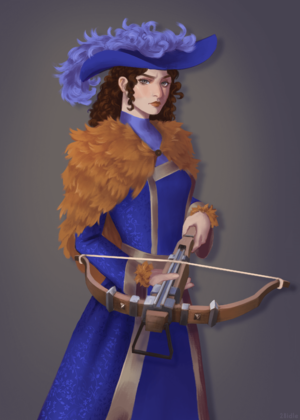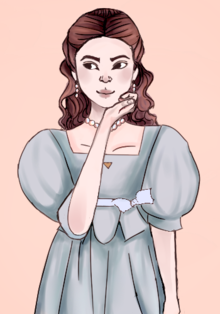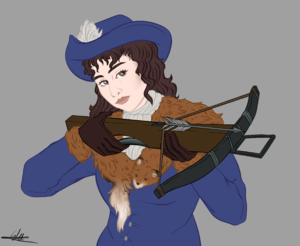Claude Élisabeth of Savoy
|
| ||||||||||||||||||||||
Princess Claude Élisabeth of Savoy (13th of Horen’s Calling, 1818 - Present) was the progenitor of the written foundations of Campagnois culture as the matriarch of the House of Pruvia via marriage. She was also a member of the Council of State of the Holy Orenian Empire under Emperor Philip III as the Director of Civil Affairs, and is remembered by the Petrine for her efforts towards female participation in the imperial government. In her middle age, she became an instrument to the Brothers' War which saw the collapse of the Empire in favor of the Kingdom of Oren, where she served as Lady Privy Seal in the Falstaff Chancellery.
She was styled as Viscountess of Provins from 1838-1844 by proxy of marriage to Lord Philip Pruvia. After her husband's ordainment as a priest, she acted as an advisor to her daughter and went by 'Lady Provins', 'Madame de Provins' or 'Lady Pruvia' unofficially while she began to foster the spirit of Campagnois culture.
Throughout her life in Oren, she was the second of the trio of Orenian Socialites that made up the ‘Madames de Savoie’, Savoyard Princesses as daughters of Prince Olivier I, restorer of Savoy in Almaris. They were raised in Orenian society within the Augustine Palace, boarded there in their youth during the reign of John VIII. A multitude of issues caused a rift between the Madames and their father only somewhat amended by their father's hand in the Aster Revolution that helped Emperor Philip III onto the imperial throne. Claude served beside her father in Philip's Council although the two were rarely seen in close proximity if ever.
Contents
Early life & adolescence
Claude was born on the the 13th of Horen’s Calling, 1818, as the second child of Olivier Renault de Savoie and Adeline Lorena Helvets during Olivier's tenure as Consul of Luciensburg. She was delivered in the Arx Rubra Palace near 2 years before it became infested with an army of hostile rat men that forced her father to process her, age 4, and her elder sister Laurène to the court of Oren, where they were placed under the care of the Countess Renzfeld. Their procession was attended by the Future Governess of the Augustine, Lady Mary Casimira, whom Claude grasped onto, calling her 'Madame Marie'. Mary would become of the two prominent women who'd be a mother figure to the de Savoie girls for the rest of their lives, the other being Maisie Adelheid d'Arkent.
As a foreigner, Claude possessed a thick auvergnat accent which fearsome courtiers ridiculed. Claude, being intensely timid in her youth, was therefore frightened by the court and buried herself within the comforts of her apartment, reading the books that littered their bookshelves to entertain herself and priming her for a love of literature. However, Laurène would notice this behaviour and forcibly wrench the girl into parties and events, where she befriended Matyas Jahan Basrid (later Count of Susa), Princess Amelia Novellen, and her greatest friend, Anastasia Ruthern (later Duchess of Furnestock). Via parties, she'd exchange her shyness for energy and charisma. This newfound confidence allowed her and her sisters to openly adorn the fashions of their homeland, inspiring the transition of the Augustine court into the Nouveau-Savoie fashions [1](1820-present) for which the 'Madames de Savoie' are now known.
A few years after their immigration, Luciensburg crumbled to finality and the rest of the de Savoies joined Claude and Laurène in Oren. The appearance of sister Eugénie completed the trio of madames. Due to their return, Claude was made to double down on canonical values as per her Savoyard paternity, and constant prayer for the cleansing of her mother's illness heavily reinforced them. Lady Mary wrote of the young girl as holding 'frightening zealotry and strong vindictions about the state of humanity, but a strange reverence for her own gender'. Lady Maisie stated that she was "in loving concordance with her returned family, seeing them as the light of her life and GOD the progenitor of it, natural for a child of her age."
Petite Potins & The Rosemoor Convention
As the Social Season of 1827 rolled nearer, Claude befriended another girl, Alina Basrid, contemporarily known as the Baroness of Carrington as wife to Baron Wilhelm. The two girls were equally avid readers, who in their joint efforts encountered the writings of Princess Elizabeth Anne Novellen, and were enamored by the fervor of her recount of events. Taking it upon themselves to emulate Elizabeth in becoming the writers of a new gossip column manifest entirely by the children of Oren, they created the instantly famous Petite Potins Column [2], it becoming a controversial yet eagerly awaited part of the social season for years to come. In her later teen years, Claude abandoned her love for the Potins after growing out of love with the fanaticism of the season, calling it a 'display of pomp frivolously exuded by those who have lost the humility of the Canon'.
The first Potins paper had an additional effect on Oren within its second article: Princess Elizabeth Anne approached the youths inviting them to publish a section about her 'Rosemoor Bill', a historical bill proposing the enfranchisement of women across the empire, allowing female nobles to inherit on the same grounds as males. Claude boldly stated to the princess that "I'll do you one better," thus beginning the Rosemoor Convention as a movement towards equal succession in the Empire, Claude's blue flower bracelet becoming the symbol of the movement as a whole. The movement was met with severe scrutiny across all fronts, but the women protested with equal severity and intense devotion, Claude writing her own piece in support as one of her first writings independent of the Potins: [3]. However, things took a turn when Princess Elizabeth brought the bill to the House of Lords and was censured by the other grandees on the grounds of unapproved publicizing of a Diet bill, one such grandee being her brother, Philip, the heir to the Empire. So stricken with grief was Elizabeth Anne that she died the year of, leaving the ladies enraged and frustrated. They answered to the censure with an accusatory letter against Philip [4], which would prompt him to pass the Elizabethan Rosemoor Bill in 1836, a few years following his ascension [5].
Blood sports & equestrianism
Olivier and a majority of the de Savoie family left Oren for Sutica around the same time as the Rosemoor Bill was gaining leeway, but the Madames de Savoie stayed in the courts, protesting that it was the only home they'd ever known. However, the dramatics of an active court become too much for the irritable adolescent Claude, who began to fiercely judge everyone around her as lacking the morality and piety that she herself exhibited. On the advice of her best friend Anastasia, an equally pious girl, she decided to leave the capital for 2 years to search for religious clarity in the forests of Dobrov. Living a life of reclusivity within a pine shack, she was taught by a religious hermit to hunt for sustenance and furs, becoming especially fond of fur collection and organic craftsmanship. Her writings of the time detailed her belief that her experience tied her to the natural way of life, the one that GOD always intended for society, and the one that she'd promote in her tenure as regent of Provins, promoting nature as one of the tenets of Campagnois culture. Thus, she became fond of all activities tied to hunting and nature, developing an obsession with weapons collecting and tracking that persisted for the remainder of her life, augmenting her distate for the Augustine Palace despite an admiration for the women that ran it.
Social Season & the Wedding of Roses
To keep up with Orenian activities in Dobrov, Claude began to exchange letters with Philip Pruvia, an older boy who had contracted her to tutor him in french mostly as a jest of chilhood. They formed an untenable bond in her absence. When her godfather and his father, Simon Casimir, noticed this, he arranged a betrothal between her and Philip with her father. This implored her to move back to Providence, where her sisters and herself purchased their own home by each acquiring jobs, which the nobility judged fiercely, creating distance between them and the palace courtiers. This was the final straw for her, and Claude decided to leave the court for good.
Claude and Philip's wedding was held in 1835 as the first event of the 1835 Social Season, remembered as 'the wedding of roses'. Sometime around the start of the Social Season, Claude's father was elevated as the ‘Duke of Corazon’ under Johanna I, Queen of Sutica. Because of their estrangement, the girls did not attempt to be diplomatic with him.
Claude’s moral prerogatives developed a hatred towards the Social season and its associated social activities, including gossip like her writings in the Petite Potins. She declared her sentiments audibly for the next several seasons, urging the children that now led the Potins to "seek GOD’s truth." She also also lamented having to participate in the season beside her sisters. On the signup of the Season, her name was written in Laurène's handwriting. In protest, she entered the season’s first debut lesson adorned in leaves and blood residual of a hunt she’d just partaken of, leading Mary Casimira, now the Governor of the Palace, to dissent her for years to come. For the debut itself, she appeared in a white debut dress layered with black over it, in what she described was an allegory for the social season: "the death of godly womanhood, darkened by the stain of ‘romantic affection’".
Claude chose her wedding date to be the first event of the season to prevent being privy to flirtation and dances with miscellaneous men. She invited her father to Oren for her wedding, it being the first time she’d seen him in various years. As Duke of Corazon, he brought his entourage to attend his daughter's wedding. Here, it was revealed that he had conceived 2 other children in Sutica: Leufroy and Athenais. Claude was outraged at her father’s neglect to reveal that she had other siblings, and her sister, Eugenie, shared the sentiment but in the form of verbal hostilities, causing her to retire to their city apartment early, Olivier in tow. With hindsight, it is now known that Olivier sent 2-3 men of Corazon to murder his daughter in cold blood, something he would admit to before High Pontiff Everard VI. Eugenie was traumatized by the event, and Claude lost any and all affection held for her father or for any of the siblings that remained at his side after the ordeal, ceasing all communication with them for a significant number of years. When their eldest brother came to attend Eugenie’s wedding following their father’s coronation as Prince of Savoy, Claude berated him for flashing his Savoyard armor in her face and threatened to draw her crossbow upon him if he did not remove it. Her family's unity would come to a grinding halt in light of these events. Additionally, Claude's dearest friend, Anastasia, would suddenly flee the state with her husband a year later, leaving Claude with little intimates in Oren save for her husband.
Viscountess of Provins; 1838-1844
In the year 1838, a series of scandals involved Philip's father, Simon Casimir. First, his wife, Princess Anne Caroline, discovered his infidelity via Lady Maisie d'Arkent. Then, she discovered his connections to the canon-blaspheming Heralds of Azdromoth, the Azdrazi. The bitter Anne Caroline would expose her husband to her father, Emperor Philip II, leading to Simon's public denouncement, the title of Viscount being thus inherited by Philip. This made Philip and Claude the 3rd Viscount and Viscountess of Provins. For a long time, Claude had spoken of Simon Casimir with great love and appreciation, with friends quoting her to have said that Simon was a father to her where her biological could not be. She and Philip equally admired the man, but his betrayal was one of the largest scandals in the history of the Novellen reign and sought to destroy the House of Pruvia as it stood. In the beginning of the year 1839, the Pruvian estate was torched down by the hand of its masters in an attempt to erase the heresy of their predecessor, a phrase being concocted by them to describe the inferno they had begun: "Cleanse that which has been tainted by the wicked; the heresy abolished in GOD’s light." [6]. Their new estate would be designed by Claude herself, named Preussens in honor of the ancestors of Pruvia [7].
After the completion of their estate, the Viscounty began a shift towards Provinois (contemporarily: Campagnois) cultural practices. Namely: Carnaval Mystique was first held in Preussens following the Pruvian 'All Hallow's Eve' tradition; Claude and Philip purebred white horses understood as symbols of purity, and a proximity to Dobrov guided them towards a mysticism in connection to the Woldzkiy forests. The former was particularly tethered to the witnessing of unexplainable magical occurrences that became an envoy to their eventual adoption of several obscure pagan practices behind closed doors.
Beyond their own culture, they began the event of the 'Coterie,' a gathering of all imperial nobles with a designated lord chosen as host for each party in succession. Generally, the Pruvias were thought to be a content and well-to-do family, ignoring some judgments placed on Claude about her despotic attitude towards her children (who she trained to answer to the command of a horse whistle) as well as her husband, a holy man with little volatility. Philip would abdicate his position in 1844 in favor of the holy cloth, leaving the Viscounty to their freshly 8-year-old daughter. Claude became her daughter’s regent for the next 8 years, being addressed as ‘Lady Pruvia’ in noble circles for the remainder of her life.
Government of the Empire; 1836-1855
Fresh out of the Social Season and with her new husband's surname, Claude was invited by Prince George Maximillian of Aldersberg to be the writer for the Providence Post, her Rosemoor Convention writings swaying her towards his favor. Claude agreed, becoming the Editor-in-Chief for the next 10 years. Around the 10th year, she was promoted to Deputy, trailing the promotion of the former deputy, Minuvas Melphestaus, to Director. Following the events of the Aster Revolution, she become Director of Civil Affairs, serving a tenure of 9 years; a large portion of the Urguani-Orenian War. She would resign after her health declined due to religious fasting motivated by Anastasia and Philip's endorsement of the Michaelite Schism.
The Aster Revolution
In the midst of a wave of government backlash against Claude ignited by her public petition in opposition to Emperor Philip II's chosen name for a Providence renovation, she received an anonymous letter detailing an urgent meeting to be held in the quarters of her father's palace in San Luciano, Savoy. The letter contained discrete details, and addressed her by a name only her long-gone friend, Anastasia, was privy to. Claude was ecstatic to behold her friend's return, and brought her daughters along for the reconnaissance. Once there, Anastasia was rumored to have disguised herself as a common maid of flaxen hair, revealing the plans of the Aster Revolution to Claude, her witnessing daughters, her sisters Eugenie and Laurene, and Lady Mary Casimira of Carrington. Little is known about the true nature of the plan, though posthumous publications from Anastasia reveal a conspiracy to have Lady Mary murder her lover, Anastasia's father-in-law, Prince Philip Aurelian, the only man standing in the way of the succession of Anastasia's husband, Philip Amadeus, to the throne of the Empire. However, this conspiracy is now known to have been a secret one between only Anastasia and Mary, with the other ladies encountering shock at its exposition some years later.
The following day, Anastasia and Philip revealed themselves before Prince Olivier's court, and petitioned for his aid in their installment upon the throne of the Empire. It all happened quite swiftly, with Anastasia and Philip utilizing Claude's daughter, the Viscountess Provins, as one of the first peers to swear allegiance to their cause. Soon after this announcement, Prince Philip Aurelian was brutally murdered by a succession of stab wounds inflicted by Lady Mary, followed swiftly by several other members of the standing Orenian government that Claude had been a gentle participant of, including the decrepitly aged Emperor Philip II himself. With Minuvas Melphestaus sworn in as Archchancellor in a matter of days, Claude was mandated to replace him as Director of Civil Affairs under Anastasia and Philip's fledgeling reign. To her dismay, her father was created Vice Chancellor to officiate his participation in the Aster Revolution, leading to Claude's unrestrained apathy towards the Chancellery.
Michaelite Schism & the Urguani-Orenian War
Anastasia and Philip vowed to continue the Urguani-Orenian War on the offensive, placing Claude in the center of a war-time government. The ministry tackled propaganda, the restructuring of the documents- destroyed since the pandemonium of the revolution -and the rejuvenation of Orenian culture. Howbeit, Claude's allegiance was tested when the Imperial pair aligned with a series of Savoyard schemes contra High Pontiff Everard VI that culminated in the Michaelite Schism, owed to affirmations of the High Pontiff's bias and politicization of the church in favor of the Kingdom of Hanseti-Ruska. For their part in the schism, Anastasia and Philip would be excommunicated twice over. Claude coursed beside them during their penance walk, and witnessed their anathematization only months after, when allegations of parricidal kinslaying came to light. This series of unfortunate events accelerated the controversial alliance of the Haeseni with Urguan in the ongoing conflict, an alliance that would prove calamitous for the unity of humanity and the Empire's survival.
Claude had always had an aversity to the Haeseni people that originated in her strong Orenian patriotism and general bias, yet her faith in the church superseded her convictions about the fragile relation between Haense and Oren. Being a constituent of an excommunicated government was quoted as "causing her severe stress that led her to seek penance with religious fasting" by contemporaries. Withal, she argued for Anastasia's innocence, cluing that she was convinced of it where kinslaying was concerned. It is widely received that the Madame refused to accept a comparison between Anastasia's newfound brashness and her father's attempted brutalizations in her younger years. Her letter versus the sedition of the Baroness Woldzmir [8] is one such writing that she latterly lamented as "a veil of her own optimism for her friend's familial integrity" (1878).
She resigned from the government in the year 1855, her fasting likening her to a withered shell of her former self.
Interlude at the Hawthorn Palace; 1855-1868
Formation of Campagnois Culture
It was around the time of her resignation that Claude's husband, Philip, set sail from the continent to pursue some or another venture across the sea. In her solitude, her passion for writing and reading were regained, willing her rediscovery of several traditions lost to the Provinois. Alongside her daughter the Viscountess, Claude set to work without delay at seeing to their reinvigoration, inviting all those peers of pronounced or vague auvergnat origin (Houses de Rosius, Halcourt, Vanderfell and Temesch) to begin the schemes of what would be a town dedicated to them: Campagnon. The design of the town was intent on the land on the western coast of Lake Province and east of the Dobrov forests, now referred to as 'Mardon', the successor state of the Campagnon project. The proof of the project lies in letters sent between Emperor Philip and the Baron of Carrington, demanding that the former need evict his provincial estate or have his belongings demolished with it. Due to unknown conflict between the interests of the houses, the project did not see the light of day but for the re-construction of the Chateau de Preussens into the Campagnois-themed Chateau d'Aubepine. However, Claude's heart remained in the interests of Campagnon. If she could not create the town, she would convince the people. Thus, she published her records of the Campagnois culture's traditions and aesthetics for all to see, and also hosted the first Maturation - the necessary trial for children to rise into adulthood. Swiftly, the auvergnat houses took up the practices, and it would become the most prominent of the auvergnat branch cultures. Some years after the project concluded, around 1865, her daughter abdicated the seat of the Viscounty and placed the regency once more under Claude, on behalf of her son Fernand Antoine.
See: The Campagnois [9]
Loss of Imperialist Views
Nearing the end of the 1850s, the Pruvia women would propose the betrothal of the third eldest daughter, Sophie, to the crown heir, Prince Peter Augustus, a proposal to which Empress Anastasia was receptive. However, Anastasia's failure to guarantee the marriage would result in Pruvia's hatred for Prince Peter, whose sudden betrothal to a Miss Ioanna of the recently treasonous House Basrid they found a grievous insult against their loyal house. The crumbling of Claude's relationship with Anastasia is detailed by an unsent letter written by the madame and preserved in a glass cabinet within her quarters, containing the words: "I shall wane into my burial grounds soon, pittering down with black wings that you have torn asunder, and what will be left of the relationship we once cherished but a cold dead hand’s reach outward?" (c.1860). Ostensibly deprived of love for the imperial administration, Claude fully reconciled with the peace of her estate, her participation in battles the only record of her attention to the ongoing war. She triumphed in the planning of well-bred marriages for all but two of her seven children, the exceptions having absconded their loyalties to Oren to join the Prince of Alstion's cause for an imperial claim, with her second youngest, Eleanor, going on to marry him.
Government of the Kingdom; 1868-1884
On the eve of Claude's 50th birthday, chaos struck the Empire once more with the death of Emperor Philip III, followed in death's tragedy by Empress Anastasia. Thus was the Empire split between the Imperialist and Royalist factions, led by Prince Peter Augustus and their thirdborn son, Prince Frederick Charles, respectfully, who disagreed on their parent's dream for the future of Empire. Frederick was able to muster a great force of Mardonic soldiers & Savoyardic refugees to destroy the declining empire and replace it with the Kingdom of Oren. His Lord Chancellor, Conrad-Armande Ashford de Falstaff, petitioned Claude for the hand of her youngest daughter to guarantee Pruvian allegiance, a deal to which she agreed on the terms that he would become the regent of Hawthorn in her place. Throughout his sparse visits to Hawthorn, Claude and Conrad would often chat regarding government and politics, developing mutual respect for one another's intellect - despite her apparent dismissiveness of his ability for self-governance. Consequently, he was apt to issue her return to the offices of Oren, and persuaded her to take up the mantle of Lady Privy Seal within his government. She would serve as his and King Frederick's right hand in many areas, additionally acting-in for the brief absences of Vice Chancellor Adrian Marcellus Novellen-Temesch.
As Lady Privy, she was directed to focus on the recuperation of the nobility's prestige. Her magnum opus was the continuation and expansion of Emperor Philip III's Adriatic [10], a mixture of the imperial diet and the earlier noble coterie. It was a private affair exclusively for nobles, taking place deep within the forests of Vienne within a large and well-guarded royal tent. Lords and Ladies were announced upon entry via trumpeter, greet the king within, and take their places by succession of rank. Then, they would be given the crown's announcements and asked input on the Kingdom's affairs, while being permitted wine and conversation. Marriages would be arranged, and, most controversially, eroded peers would be audited. Her own grandson would be stripped of his title as Count of Provins, with Claude stating briskly that she "had done all [she] could to maintain a House that would not carry her name as its legacy". Castle Hawthorn would be rewarded to Conrad as the Barony of Guise to ensure it would remain in Claude's keeping, and she would live there with her grandchildren until her death.
As an addendum to the Adriatic, she scripted the Orenian Noble Code [11], which detailed the functions of nobility within the Kingdom, as well as redesigned the charter of noble letters to include greater detail on the peer's rights to said title (example: [12]).
Death & Burial; 1884-1893
When the Kingdom fell into civil war by way of the Acre rebellion, Claude was said to have recessed within the government due to her disapproval of Conrad's replacement as Chancellor, a Sir Elric Castile. Succeeding the Kingdom's collapse in the year 1884, she remained at leisure within the walls of Castle Hawthorn, and resisted being evicted by its exchange between firstly the Harvest Confederacy, then the Kingdom of Aaun, then the Archduchy of Petra, under which she would later die peacefully at the age of 75, having lived a life of much adaptation and continued patriotism to the heartlands. She was buried beneath the dirt of her stables within a marble coffin carved with her name in proper flexio: Claudia Isabela Sabaudiae. It is rumored that the heart of her final steed, named Philippe for her late husband, was ripped from its body to be buried with her in the norlandic manner, however this is largely held as rumor by those closest to her.
Issue
| Name | Birth | Death | Marriage | |
|---|---|---|---|---|
| Amadie Marléne Élisabeth | 14th of Godfrey’s Triumph, 1836 | Alive | Charles Alexander of Carrington | Firstborn child of Philip and Claude. 1st Countess Provins. |
| Anastasie Thérèse Caroline | 11th of Horen's Calling 1838 | Alive | Balthazar III, Margrave of Myrine | |
| Guillaume Louis Michel | 12th of Owyn's Flame, 1843 | Alive | (1) Ophelia Vuiller (2) Héloïse Halcourt |
Married matrilineally, later divorced. Married again and created a new branch of Pruvia, House de Rochefort. |
| Jean Henri Antoine | 5th of Sigismund's End, 1844 | 1st of Sigismund's End, 1878 | Unmarried | Was disowned from the family after siding with the Imperialists in the Brothers' War. |
| Sophie Clémentine Isidore | 5th of Horen's Calling, 1849 | 1919 | Count Aleksander of Susa | |
| Eleanor Lucienne Adelaide | 4th of Horen's Calling, 1850 | Alive | Charles I, King of Aaun | Was disowned from the family after siding with the Imperialists in the Brothers' War. |
| Mathilde Cypriélle Angélique | 2nd of Sun's Smile, 1851 | Alive | Baron Conrad of Guise, Lord Chancellor of Oren |
|





